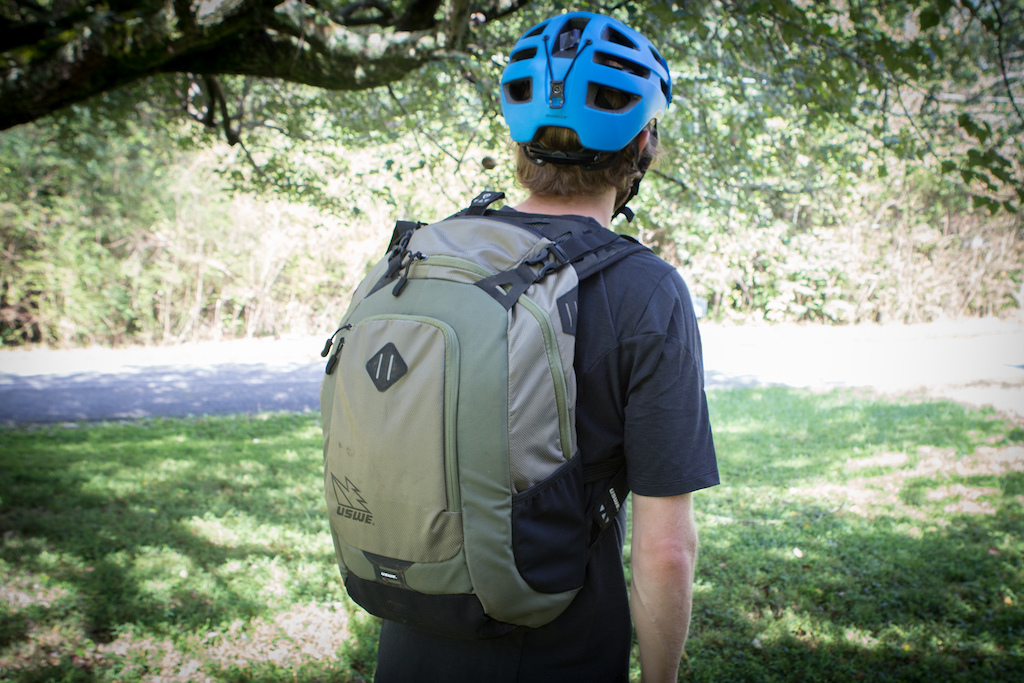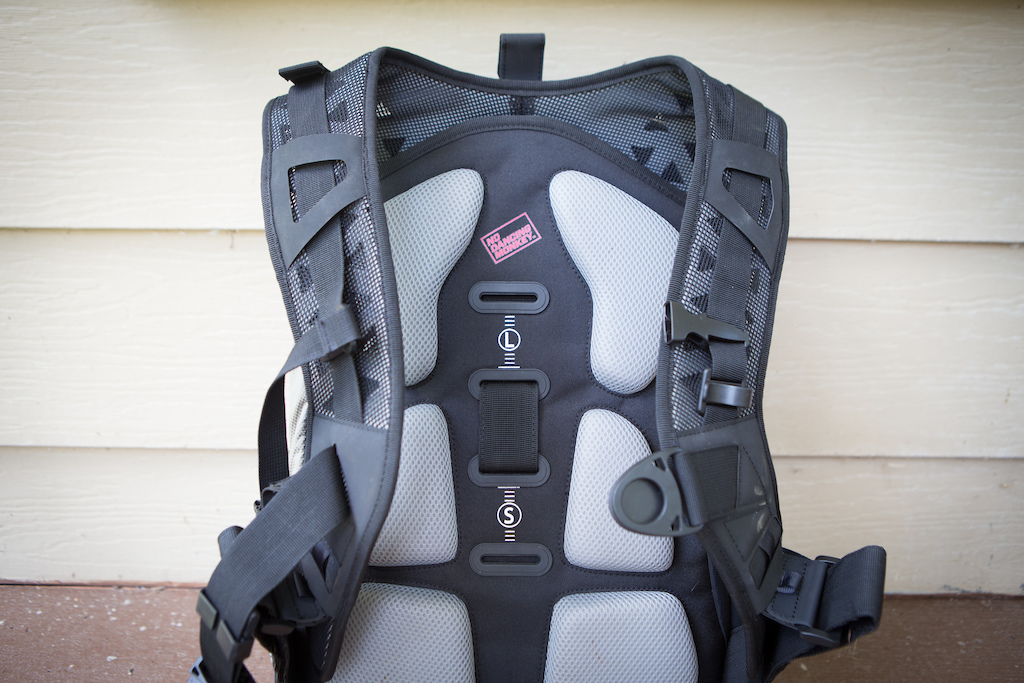Review: USWE Explorer 26 Backpack
For the last several years, I've avoided backpacks as much as I can, choosing instead to attach a water bottle and most of my gear directly to my bike. However, there are limits to that method, and for big missions a pack is still necessary, which is where something like USWE's Explorer 26 comes in. It has a generous amount of room, but is designed to stay in place and not be overly cumbersome, even when it's loaded up with enough gear for a night in the woods.
The Explorer 26 is classified as an "adventure pack" - designed for, as they say, "heavy all day long adventures." It utilizes USWE's heavy duty suspension system, has a spot for a hydration bladder, gear, a rain cover, and a multi-size adjustable backplate. It sells for $150 USD
The Explorer 26 is classified as an "adventure pack" - designed for, as they say, "heavy all day long adventures." It utilizes USWE's heavy duty suspension system, has a spot for a hydration bladder, gear, a rain cover, and a multi-size adjustable backplate. It sells for $150 USD
Explorer 26 Details:
• 26L capacity
• Size adjustable backplate
• Rain cover
• Hydration bladder compatible (not included)
• Colors: Black, Green
• Weight: 1069 grams
• MSRP: $150 USD
• www.uswe-sports.com
• 26L capacity
• Size adjustable backplate
• Rain cover
• Hydration bladder compatible (not included)
• Colors: Black, Green
• Weight: 1069 grams
• MSRP: $150 USD
• www.uswe-sports.com
Construction
What sets the Explorer 26 apart from other similarly sized packs is the fact that there's no waist strap. Instead, USWE use a 4-point suspension harness comprised of two curved shoulder straps that are fastened in the middle by a thick strap across the chest and a one click buckle. There are adjustable straps that go from the main shoulder straps across the top of the pack to the front of the bag to help keep the pack secured, and there's an additional elastic chest strap above the main strap. The side straps have some elasticity built in for comfort and are also adjustable. The backplate has the ability to adjust between three different sizes so that users can fine-tune the bag to their body.
There is a spot for a water reservoir, a large main compartment, and then a smaller compartment for organizing gear and essentials. Additionally, there's a media pocket with a waterproof zipper and a water-resistant pocket for a phone. For those times when the rain is more than just a passing shower, there's a rain cover that stows away beneath the bottom of the pack.
Adjustable straps to keep things where they should be.
Performance
Taking the time to adjust the Explorer 26 to fit your body is crucial. I found that my 5'10" frame meshed well with the pack's back set in the medium position and within a few minutes of other minor and simple adjustments I was off riding. The majority of my time with the pack was spent pedaling up steep mountains loaded down with camera and food supplies for a full day of filming. When climbing the pack is comfortable and breathes as well as most any other bag I've used...let's be real, nothing on your back, especially in muggy weather, is ideal. The straps don't dig into me in any way, and although I was at first hesitant about the large strap across my sternum, it was barely noticeable.
Descending is when a bag really needs to earn its keep, and the Explorer did just that. Even with several kilos of gear just tossed in the bag, with no regard for properly loading the heaviest items first or when the bag was only half full, things stayed in place. I felt very stable riding with it on, even in sketchy terrain, and there was minimal movement side to side or up and down. The lack of a hip belt was noticeable - in a good way - and although I feel that having one could have helped negate the very small amount of movement that there was, without it, the pack still sits more securely on my back than most others I have used.
The bag is not small but I'm probably not riding with a backpack unless it's for an extended excursion into the forest. The main compartment here is holding a tube, pump, Jetboil, fuel, coffee, coffee cup, ENO hammock, sleeping pad, rain shell, a small camera in a Pelican case, and some food with room to spare. The smaller outside compartment holds a multi-tool along with a few other trailside repair necessities in the zippered pouch, a knife, water filter, and then a headlamp and my keys in the other zippered pouch. There's room for more but this is enough for a quick overnight in the summer.
Pinkbike's Take
Author Info:
Must Read This Week
Sign Up for the Pinkbike Newsletter - All the Biggest, Most Interesting Stories in your Inbox
PB Newsletter Signup








So what is the benefit of not having a waist strap?
riding a bike is completely different to hiking. most of the weight is going to be on your back somewhere given the riding position (i.e. bent over at around 45 deg more or less) whether you like it or not, your hips move differently, your lower back is arched with opposite curve to when you're walking, and maybe most important, your waist is compressed at the front and not in a good position to transfer any weight from a hip belt to your hips (no or less room for the belt). plus it's a pain in the ass to move around on the bike when there is stuff around your hips. in my experience every riding backpack with a waistband is uncomfortable to pedal with it set at any level of tightness required to bear some of the load (hence my waistband is loose on every riding pack I've had).
i have a lightweight camelbak (10l thing) for endurance racing without a waist belt and it's infinitely more comfortable. it also has pockets on the shoulder pads at the front around chest height, which are easier to access than waist pockets. I wouldn't try and carry a tent in it, but the design principle seems to work.
I am using a Fjällräven Friluft 35. Hundreds of kilometers of trails with it, no complaints.
Definitely more playful and infinitely better for jumping
Not so good for the other 48.1% of humans with boobs.
However while climbing I often unclip the sternum strap to allow my chest to expand and breathe easier while the backpack is still held in place by the hip belt.
How would that work here? Seems like both straps would have to be unclipped and then the pack would only rest on the shoulders.
I commute with a laptop, food and clothes in the bag and you cannot feel the weight when on your back at all. it doesnt move around and never feel the need for a waist strap.
Since i had the XC bag, i have never considered any other bags. USWE are simply the best bags available for riding.
The USWE strap system is spectacular. With 2L of water, a couple of bars, a pump and my emergency sawyer filter for filtering water on 6 hour+ rides in the backcountry, I have no movement and never have any need to unfasten the straps because I literally forget the pack is there.
I can see the argument for a waist strap for hiking/walking and with a heavier pack. But if you are minimalist like I am, the small USWE packs are the absolute best thing for mountain biking that I've ever tried.